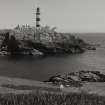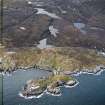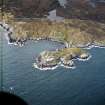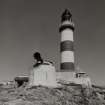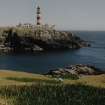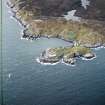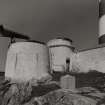Scalpay, Eilean Glas Lighthouse, Foghorn
Fog Horn (20th Century)
Site Name Scalpay, Eilean Glas Lighthouse, Foghorn
Classification Fog Horn (20th Century)
Alternative Name(s) Scalpaigh; North Minch
Canmore ID 268315
Site Number NG29SW 1.06
NGR NG 24743 94699
Datum OSGB36 - NGR
Permalink http://canmore.org.uk/site/268315
- Council Western Isles
- Parish Harris
- Former Region Western Isles Islands Area
- Former District Western Isles
- Former County Inverness-shire
NG29SW 1.06 24743 94699
The fog signal was installed in 1907, its character at the time being 1 blast of 7 seconds every 1½ minutes. The fog signal was eventually discontinued in 1987. (NLB) The foghorn is set on a pivoting rail, with nearby associated compressed air tanks.
Part of a lighthouse complex with circular lighthouse towers, main tower designed by Robert Stevenson circa 1825 superseding 1789 tower. This is a classic example of a lighthouse complex which encompasses the lighthouse, accommodation for the keepers and their families, means of transport with the jetty and a means of subsistence with fields and walled garden. It forms a distinctive grouping in a remarkable setting. This site also documents the development of the lighthouse with the earlier tower being one of the first 4 lighthouses commissioned by the Northern Lighthouse Board, which had been formed 3 years earlier. The lamp was first lit on October 16th 1789, a plaque on the original keeper's house mentions Alexander Reid, the first keeper who came in 1789 and stayed for 35 years. (Historic Scotland)
Project (4 June 2015 - 5 June 2015)
A condition survey of the Eilean Glas lighthouse complex, Scalpay, undertaken on behalf of Comhairle nan Eilean Siar on 4 and 5 June 2015.
Field Visit (4 June 2015 - 5 June 2015)
Foghorn emplacement. Red steel funnel-shaped foghorn protrudes from roof of elevated roughly square control room, all set within c.3m tall horseshoe-shaped mass concrete wall. Foghorn is set on cog and track mechanism to allow rotation around the top of the concrete external wall. Steps and a small ladder provide access from the north. The foghorn was supplied by a pipe leading from the compressed air tanks (350421). Constructed 1907.
One of the first four lighthouses constructed by the Northern Lighthouse Commissioners, construction began on Eilean Glas lighthouse in 1787 . It was first lit on 10 October 1789, and the site has continued to operate through successive phases of development to the present day. The development of the lighthouse can be summarised in four phases: the construction of the first lighthouse and associated buildings in 1787-9; the construction of the second (current) lighthouse and associated buildings in 1824; the construction of a new keeper’s cottage and foghorn in the early twentieth century; and the development of technological infrastructure during the twentieth century, including aerial masts and the helipad.
This structure dates from the third period of the site’s development. At the beginning of the twentieth century the station was upgraded to include a foghorn, which necessitated the creation of several new structures: the foghorn itself (268315), which had the ability to rotate; a large building housing the engine room for the air compressors, a radio room and an additional keeper to operate the foghorn (317295); and a bank of smaller compressed air tanks which connected the two (350421). These were constructed between 1901 and 1907, and may comprise one of the oldest surviving foghorn installations in Scotland.
The lighthouse was automated in 1978, which resulted in the majority of structures on the site no longer being required by the NLB . In 1982 and 1984 these were sold into private ownership . At this point a modern foghorn and an aerial mast were still operational; these have since been decommissioned.





















